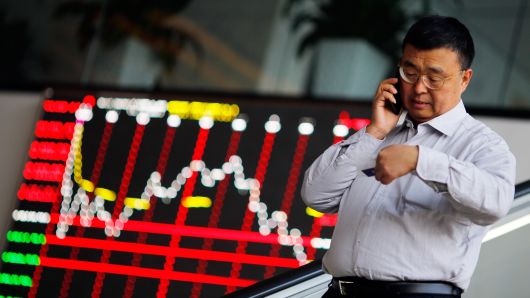
A flurry of comments from Chinese officials over the last few days have been aimed at pledging support for private businesses with financing problems, as Beijing seeks to ease fears of a sell-off in stocks.
The worry is that a drop in stock prices would force the selling of shares used as collateral, and lead to further market declines in China.
In one of Beijing’s latest interventions, the Securities Association of China announced Monday night that 11 securities firms will form a $100 billion yuan ($14.5 billion) asset management plan to take some pressure off “share pledges” for companies with good development prospects.
In share pledge financing, companies use a percentage of their equities as collateral to obtain loans. If the stock price falls far below a level that was agreed upon, the lender will sell the shares to obtain funds, leading to the destabilization of equity markets.
Despite Beijing’s latest move and other recent measures to support local businesses, stocks closed sharply lower Tuesday, giving back some gains from the rally in the previous two sessions.
The Shanghai composite has fallen more than 20 percent this year amid worries about economic slowdown and rising tensions with the United States, China’s largest trading partner. It is one of the world’s worst performing stock markets in 2018.
Most analysts say that stock pledges don’t pose a systemic risk right now. But the issue points to the challenges facing China’s private enterprises, which state media says contribute to 80 percent of jobs.
The prevalence of share pledges is partly the result of Beijing’s own actions. Chinese banks prefer to lend to state-owned enterprises, while the government continues to crack down on shadow banking — the primary alternative for private businesses. As a result, many Chinese companies, especially small and mid-sized businesses, have turned to share pledges.
Of the total market capitalization for the mainland-traded A shares, about 10 percent – or 4 trillion yuan – is pledged as collateral, according to several financial analysts.
Goldman Sachs’ China strategist Kinger Lau said in a note on Saturday that based on data at that time, about 1 trillion yuan of stock-pledged loans could face the risk of a margin call to pay up. That figure increases by about 100 billion yuan if the stock market falls 5 percent, the report said.
Lau pointed out that governments in Beijing, Shenzhen and Hangzhou announced last week that funds will be established to help local firms with share pledge difficulties.
“Against the backdrop of high leverage and weak sentiment in both the real economy and financial market, it is critical for the government to restore confidence among the people,” J.P. Morgan Asset Management global market strategists, Marcella Chow and Chaoping Zhu, said in a Monday report.
They said the monetary easing and re-leveraging measures Beijing used in the wake of 2015’s market crash and economic softness may no longer be effective, and foresee more tax reforms.
The announcement of a 100 billion-yuan funding plan came on Monday, a day after the State Council’s Financial Stability and Development Committee convened for a meeting.
Also in the past week, key financial entities announced plans for bond financing and new funding channels, the government released a draft for temporary reduction in personal income tax and top financial regulators published remarks in support of the economy and markets.
In a letter on Sunday disseminated by state news agency Xinhua, Chinese President Xi Jinping told entrepreneurs he supports their development and that any words or actions that weaken the private economy are wrong.
“Most of these statements aren’t new, but they’re a reminder,” Thomas Gatley, a Beijing-based corporate analyst at research firm Gavekal Dragonomics, told CNBC in a phone interview on Monday. “If these pronouncements don’t lead to a radical influx of liquidity, which I don’t think they will, then we’re not going to see day after day of [massive gains].”
The Shanghai composite soared more than 4 percent Monday in its best day since March 2016, following a rally of more than 2 percent on Friday.
But if history is any guide, such upswings are not indicative of a positive trend.
According to Bespoke Investment Research, there have been 32 trading sessions since 2008 that saw gains of 4 percent or more on the Shanghai composite – and most of those gains took place during the index’s decline in 2008 and 2015.
It’s not clear whether the new government policies can deliver economic stimulus – and market gains – in the near term, said Yongyuan Yao, a researcher at Nanhua Futures, in a note Tuesday that was based on September’s data.
“In the medium to long-term, we think we should watch whether domestic policy will be reflected in the macroeconomy,” Yao said, according to a CNBC translation. “If the economy begins to recover in the fourth quarter, A shares will climb in the medium term.”